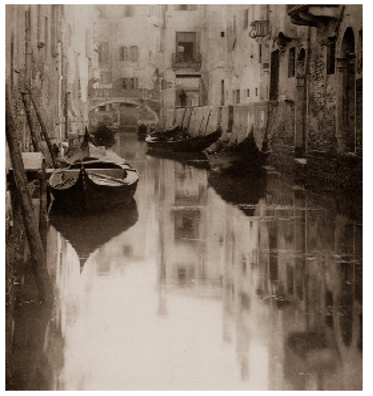Introduction
Born in New Jersey, in the year 1864, Alfred Steiglitz was a very successful photographer in the US during the 1800s. Greer Muldowney is a very popular young female photographer, who was born in 1988. This paper presents a biography of Alfred Steiglitz and Greer Muldowney. Besides, the treatise attempts to carry out a comparative analysis of the photos done by the two photographers. Specifically, the comparative review is based on color, light or shadow, and composition.
Brief Biography
Alfred Steiglitz lived between 1864 and 1946. The US-based photographer had a very successful career spanning nine decades. Born in Hoboken, Alfred was a son of German-Jewish immigrants who lived in New Jersey (Stieglitz 23). The young Alfred attended the prestigious Charlier Institute before moving to Germany for further studies. After returning to the US in 1887, he bought his first tripod and camera. In the same year, his photography career received a boost after winning the coveted photographic competition that attracted entrants from the US, Germany, and England.
Alfred established a series of art studios across the US in the late 1880s, where he exhibited series of personal photography works such as the Winter-Fifth Avenue of New York, Venetian Canal, and Intimate Voyage, among others (Encyclopedia of Visual Artists). Some of the most expensive photos taken by Alfred are the Georgia O’keeffe and Georgia O’keeffe Nude, which are valued at $7 million (Stieglitz 23).
At the age of 29 years, Greer Mudlowney has created a niche in her career as a specialist in landscape and architecture photography. Born in the city of Boston, Greer has had a successful career spanning to a decade and has received the coveted photography professor honors at Clark University (Muldowney). Besides taking pictures, Greer is a tutor of photography classes at Boston University. Over the years, she has won several exhibition awards in the US and across the globe. Many of Greer’s photos have been published in many local and international magazines. In the year 2014, she received the prestigious Massachusetts Cultural Council’s PDN 30 award (Muldowney). The most famous work attributed to Greer is The Hong Kong Tenements.
Comparative Analysis: Photos of Greer and Alfred
The comparative analysis examines the Venetian Canal (1894) by Alfred Stieglitz and the Hong Kong Tenements (2009) by Greer Muldowney. The review covers photo description, composition, color, and light.
Description of the Pictures
As captured in Figures 1 and 2, the Venetian Canals and the Hong Kong Tenements were taken in the 20th and 21st centuries, respectively. The first picture was taken in the US while the second photo was taken in Japan, as presented in the images below.


The Venetian Canal photograph was taken by Alfred in 1984. The picture covered a frame of several boats floating on a canal that has story structures on each river bank. In the background, there is a concrete bridge connecting the structures on either side of the river. The photo covers a wide frame. This is a black and white picture. The Hong Kong Tenements photograph was taken by Greer in the year 2009. The frame of this picture covers high-rise buildings that are concentrated in a relatively small space. The photograph has covered more than 20 images of story buildings of different shapes and colors.
Composition
The Venetian Canal picture covers several high-rise buildings along a canal. The structures are of different shapes and belong to the old architectural designs. There are more than five images of boards anchored on either side of the canal. The background of the picture covers a light bridge that connects the two sides of the canal. The images of the boats, structures, and bridge are reflected by the water flowing in the canal.
In comparison, the Hong Kong Tenements photograph can be described as a landscape picture. Taken in a high-density area, there are more than twenty different modern story structures. The buildings are crowded in the frame of the picture. The picture was taken at night since the lights from these structures are visible. In addition, the background captured a clear reflection of semi-dark skies.
Color
The Hong Kong Tenements is a colored image. Taken by modern colored lenses, the photograph is very clear and captures all colors within the frame. There is a perfect balance of coloration to create an apparent contrast between the foreground and background. On the other hand, the Venetian Canal is a black and white picture. All the images in the picture are either white or black as the contrasting effect. The foreground and background have a similar shading effect.
Light
The Venetian Canal image was taken in the day, probably at noon, since the shadows fall beneath each image. On the other hand, the Hong Kong Tenements were taken at night since the lighting reflection from each structure is very clear. Generally, the Hong Kong Tenements image is clearer than the Venetian Canal. Besides, the contrast between the foreground and background in the Venetian Canal is not comprehensible.
Conclusion
Alfred Steiglitz and Greer Muldowney are photographers of the 1800s and 2000s, respectively. The comparative analysis of the Venetian Canal (1894) by Alfred Stieglitz and the Hong Kong Tenements (2009) by Greer Muldowney revealed variations in light, composition, and color.
Works Cited
Encyclopedia of Visual Artists. “Alfred Stieglitz.” visual-arts-cork. Web.
Muldowney, Greer. “Photography.” GreerMuldowney. Web.
Stieglitz, Alfred. Picturesque Bits of New York and Other Studies. R. H. Russell. 1897.